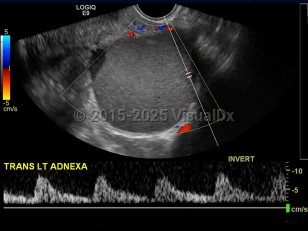Endometriosis
Alerts and Notices
Important News & Links
Synopsis

The endometrium is the innermost lining layer of the uterus. Its function is to stabilize and support an early pregnancy. When fragments of endometrial lining are found outside of the uterine cavity, this is referred to as endometriosis.
The exact etiology of this condition is unclear, but the prevailing thoughts are toward retrograde menstruation (endometrial fragments pushed into the abdomen through the fallopian tubes) and localized lymphatic spread. Areas affected can include all abdominal organs but most commonly involve the ovaries, bladder, fallopian tubes, and the uterine support ligaments. Less common sites of involvement may include the umbilicus, incisional scars, and the omentum.
Each month, due to hormone effects, lesions cycle through changes that ultimately lead to scar tissue and adhesions. This cycling process and scarification cause chronic inflammation and pain.
Risk factors include early age of menarche, shorter menstrual cycles, family history, longer menstrual flow, low body mass index, and nulliparity.
Endometriosis affects approximately 6%-10% of women of reproductive age. Presenting symptoms can be nonspecific and variable but may include fatigue, cyclic pelvic pain, pain with intercourse, abdominal pain, chronic pain, painful periods, or pain with bowel movements or a full bladder. This condition can also be completely asymptomatic and only present as infertility (which affects about one-third of patients) or as an incidental finding at the time of an unrelated surgery. It is sometimes associated with somatic mutations in the ARID1A, PIK3CA, KRAS, or PPP2R1A genes.
Related topics: cutaneous endometriosis, thoracic endometriosis
The exact etiology of this condition is unclear, but the prevailing thoughts are toward retrograde menstruation (endometrial fragments pushed into the abdomen through the fallopian tubes) and localized lymphatic spread. Areas affected can include all abdominal organs but most commonly involve the ovaries, bladder, fallopian tubes, and the uterine support ligaments. Less common sites of involvement may include the umbilicus, incisional scars, and the omentum.
Each month, due to hormone effects, lesions cycle through changes that ultimately lead to scar tissue and adhesions. This cycling process and scarification cause chronic inflammation and pain.
Risk factors include early age of menarche, shorter menstrual cycles, family history, longer menstrual flow, low body mass index, and nulliparity.
Endometriosis affects approximately 6%-10% of women of reproductive age. Presenting symptoms can be nonspecific and variable but may include fatigue, cyclic pelvic pain, pain with intercourse, abdominal pain, chronic pain, painful periods, or pain with bowel movements or a full bladder. This condition can also be completely asymptomatic and only present as infertility (which affects about one-third of patients) or as an incidental finding at the time of an unrelated surgery. It is sometimes associated with somatic mutations in the ARID1A, PIK3CA, KRAS, or PPP2R1A genes.
Related topics: cutaneous endometriosis, thoracic endometriosis
Codes
ICD10CM:
N80.9 – Endometriosis, unspecified
SNOMEDCT:
129103003 – Endometriosis
N80.9 – Endometriosis, unspecified
SNOMEDCT:
129103003 – Endometriosis
Look For
Subscription Required
Diagnostic Pearls
Subscription Required
Differential Diagnosis & Pitfalls

To perform a comparison, select diagnoses from the classic differential
Subscription Required
Best Tests
Subscription Required
Management Pearls
Subscription Required
Therapy
Subscription Required
References
Subscription Required
Last Reviewed:08/29/2017
Last Updated:06/21/2021
Last Updated:06/21/2021
Endometriosis

